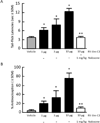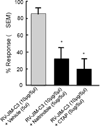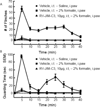Novel fentanyl-based dual μ/δ-opioid agonists for the treatment of acute and chronic pain
- PMID: 24084045
- PMCID: PMC3962292
- DOI: 10.1016/j.lfs.2013.09.016
Novel fentanyl-based dual μ/δ-opioid agonists for the treatment of acute and chronic pain
Abstract
Approximately one third of the adult U.S. population suffers from some type of on-going, chronic pain annually, and many more will have some type of acute pain associated with trauma or surgery. First-line therapies for moderate to severe pain include prescriptions for common mu opioid receptor agonists such as morphine and its various derivatives. The epidemic use, misuse and diversion of prescription opioids have highlighted just one of the adverse effects of mu opioid analgesics. Alternative approaches include novel opioids that target delta or kappa opioid receptors, or compounds that interact with two or more of the opioid receptors.
Aims: Here we report the pharmacology of a newly synthesized bifunctional opioid agonist (RV-Jim-C3) derived from combined structures of fentanyl and enkephalin in rodents. RV-Jim-C3 has high affinity binding to both mu and delta opioid receptors.
Main methods: Mice and rats were used to test RV-Jim-C3 in a tailflick test with and without opioid selective antagonist for antinociception. RV-Jim-C3 was tested for anti-inflammatory and antihypersensitivity effects in a model of formalin-induced flinching and spinal nerve ligation. To rule out motor impairment, rotarod was tested in rats.
Key findings: RV-Jim-C3 demonstrates potent-efficacious activity in several in vivo pain models including inflammatory pain, antihyperalgesia and antiallodynic with no significant motor impairment.
Significance: This is the first report of a fentanyl-based structure with delta and mu opioid receptor activity that exhibits outstanding antinociceptive efficacy in neuropathic pain, reducing the propensity of unwanted side effects driven by current therapies that are unifunctional mu opioid agonists.
Keywords: Allodynia; Chronic pain; Delta opioid; Fentanyl; Formalin flinch; Hyperalgesia; Inflammatory; Mice; Naloxone; Rat; Spinal nerve ligation; mu opioid.
© 2013. Published by Elsevier Inc. All rights reserved.
Figures







References
-
- Abbott FV, Ocvirk R, Najafee R, Franklin KB. Improving the efficiency of the formalin test. Pain. 1999;83:561–569. - PubMed
-
- Basbaum AI, Gautron M, Jazat F, Mayes M, Guilbaud G. The spectrum of fiber loss in a model of neuropathic pain in the rat: an electron microscopic study. Pain. 1991;47:359–367. - PubMed
-
- Cavalli A, Bolognesi ML, Minarini A, Rosini M, Tumiatti V, Recanatini M, Melchiorre C. Multi-target-directed ligands to combat neurodegenerative diseases. J Med Chem. 2008;51(3):347–372. - PubMed
-
- Chen L, Schneider S, Wax P. Knowledge about acetaminophen toxicity among emergency department visitors. Vet Hum Toxicol. 2002;44(6):370–373. - PubMed
MeSH terms
Substances
Grants and funding
LinkOut - more resources
Full Text Sources
Other Literature Sources
Medical
Research Materials
Miscellaneous

